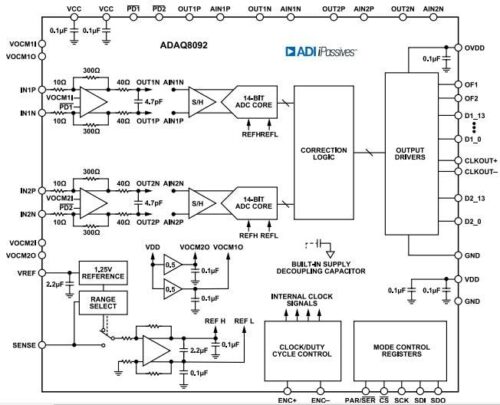Analog Devices Inc. has launched ADAQ8092 14-Bit 105 MSPS μModule which features a high-speed dual-channel data acquisition (DAQ) solution.
Computers work on digital data but the real world is analog. And to process this analog data using computers we need to convert it into digital data. As simple as it sounds for us, it turns out to be a pretty rough journey for engineers to process the same. With advancement in computer intelligence the processing takes a complex turn. Single inputs are barely a case nowadays, and multiple inputs give rise to a system which can be referred to as an intelligent system.

Analog Devices Inc. has introduced ADAQ8092 14-bit MSPS μModule with a high speed dual-channel data acquisition(DAQ) solution. The multi-channel DAQ system is basically a signal chain sub-system interfaced to multiple inputs (typically sensors) with the main function of converting the analog signal at the inputs into digital data that a processing unit can comprehend.
The device features signal conditioning, an analog-to-digital (ADC) driver, a voltage reference, and an ADC in a single package. μModule solutions simplify the development of high-speed data acquisition systems by transferring the design burden, component selection, optimization, and layout from the designer to the device. The ADAQ8092 enables a 6× footprint reduction. Built-in power supply decoupling capacitors enhance power supply rejection performance, making it a robust DAQ solution. The operating temperature range of the ADAQ8092 is −40°C to +105°C.
FEATURES
- Dual-channel simultaneously sampling ADC
- Integrated differential amplifier/ADC driver
- Single-ended to differential conversion
- Package footprint, 7 mm × 6 mm, 72-ball CSP_BGA
- 6× footprint reduction vs. discrete solution
- On-chip reference circuitry with VOCM generation
- CMOS, DDR CMOS, or DDR LVDS outputs
- Optional data output randomizer
- Optional clock duty-cycle stabilizer
- Shutdown and nap modes
- Serial SPI port for configuration
The multi-channel system enables a wide range of applications which includes communication systems, cellular base station systems, human-computer interfaces and several other research and development fields based on signal processing.








